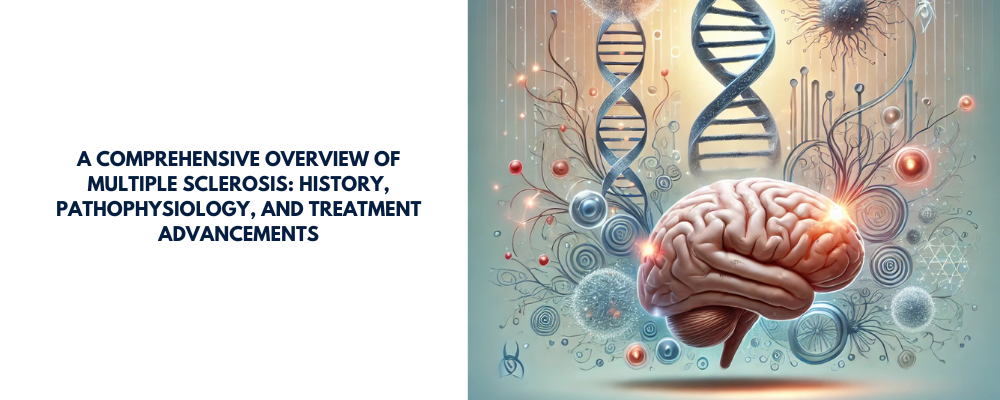A Comprehensive Overview of Multiple Sclerosis: History, Pathophysiology, and Treatment Advancements

Multiple sclerosis (MS) is a complex, immune-mediated disease targeting the central nervous system (CNS). It is marked by inflammation, demyelination, and neurodegeneration, leading to varying degrees of neurological dysfunction. The review by Ibrahim M. Dighriri et al., published in Cureus (2023), offers an in-depth analysis of MS, covering its historical background, pathophysiology, and therapeutic advancements.
A Historical Perspective
The first documented case of MS dates back to Saint Lidwina of Schiedam in the 14th century. Later, Augustus d'Este chronicled his progressive symptoms, including optic neuritis and motor impairments. In the 19th century, Jean-Martin Charcot formalized the understanding of MS as a distinct disease. His students further linked clinical symptoms to pathological findings, laying the foundation for modern diagnostics.
Pathophysiology: A Complex Interplay
The pathology of MS is driven by autoimmune mechanisms where autoreactive T and B cells breach the blood-brain barrier (BBB). These immune cells attack myelin, leading to plaque formation, axonal damage, and neurodegeneration. Key cellular players include:
T Cells: CD4+ Th1 and Th17 cells produce pro-inflammatory cytokines like interferon-gamma and IL-17, exacerbating tissue damage.
B Cells: These contribute to disease through antibody production and antigen presentation, often harboring latent Epstein-Barr Virus (EBV).
Microglia and Macrophages: These cells release inflammatory cytokines and reactive oxygen species, amplifying neurodegeneration.
Risk Factors and Epidemiology
MS arises from a multifactorial interaction between genetics, environment, and lifestyle:
Genetics: The HLA-DRB1*1501 allele is strongly associated with MS susceptibility. Family studies show heritability rates between 35% and 75%.
Environmental Factors: Low vitamin D levels, higher latitude residency, and EBV infection are well-documented risk factors.
Lifestyle: Smoking and physical trauma can exacerbate MS progression.
The disease predominantly affects individuals aged 20-40, with a female-to-male ratio nearing 3:1. Its prevalence is highest in Northern Europe and North America, with emerging evidence of comparable rates in African-American populations.
Advances in Diagnosis
The McDonald criteria remain the gold standard for MS diagnosis, emphasizing the dissemination of CNS lesions in time and space. Magnetic resonance imaging (MRI) plays a critical role, revealing asymptomatic lesions that often precede clinical manifestations.
Therapeutic Landscape
The management of MS has evolved dramatically with the advent of disease-modifying therapies (DMTs). These aim to reduce relapse rates, slow disability progression, and limit CNS inflammation. Key therapies include:
Highly Effective DMTs:
Ocrelizumab: A CD20-targeting monoclonal antibody effective in both relapsing and primary progressive MS.
Natalizumab: An α4β1 integrin inhibitor that prevents lymphocyte migration across the BBB.
Moderately Effective DMTs:
Fingolimod: The first oral therapy that modulates sphingosine-1-phosphate receptors to prevent lymphocyte egress.
Dimethyl Fumarate: Known for its anti-inflammatory and neuroprotective properties.
First-Line Therapies:
Interferon-beta and glatiramer acetate remain foundational treatments for relapsing-remitting MS (RRMS).
Although these therapies have revolutionized care, challenges remain in addressing the neurodegenerative aspects of MS, which persist despite effective control of inflammation.
Future Directions
Emerging therapies focus on personalized medicine, leveraging biomarkers to predict treatment response. Ongoing research into remyelination and neuroprotection holds promise for halting disease progression. Long-term real-world studies are essential to confirm the safety and efficacy of newer DMTs.
Conclusion
Multiple sclerosis exemplifies a complex interplay of genetic, environmental, and immunological factors. While significant strides have been made in its management, unmet needs in progressive forms of the disease highlight the importance of continued research. The review by Dighriri et al. serves as a valuable resource, shedding light on the multifaceted nature of MS and guiding future clinical and research endeavors.
Reference:
Dighriri, I. M., Aldalbahi, A. A., Albeladi, F., Tahiri, A. A., Kinani, E. M., Almohsen, R. A., ... & Altowairqi, F. K. (2023). An overview of the history, pathophysiology, and pharmacological interventions of multiple sclerosis. Cureus, 15(1).
